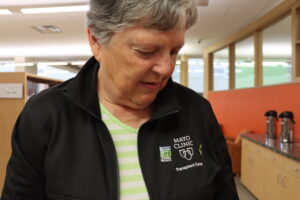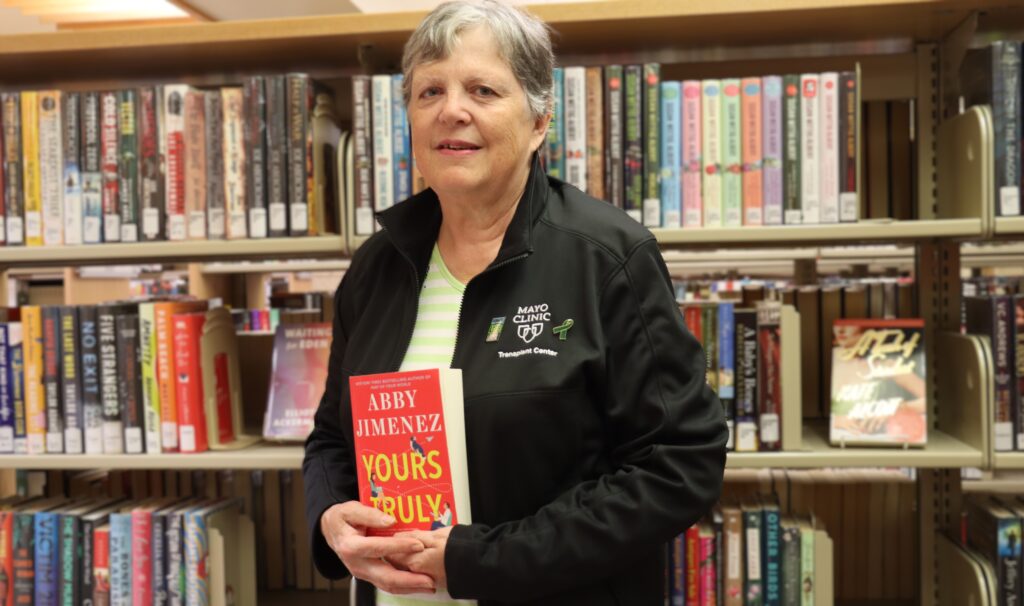If you believe in Godwinks – messages from God telling you that you are not alone and that everything will be O.K. – this story about a Nevada woman who became a “live” kidney donor may strengthen your belief.
Emily Fulton, 69, who has lived in Nevada for a little over five years with her husband, Bob, said April was Donate Life Month and it made her think that maybe she could inspire others by sharing her story, a story that started, she said, with “Godwinks.”
“2023 was full of them,” Emily noted.
It started in January of 2023 when her 98-year-old mother-in-law entered the hospital with end-stage kidney failure, which caused extreme leg pain and immobility. Coupled with severe anemia, the kidney failure ended her life in February. (Godwink 1)
In April 2023, Emily was visiting with her sister, Esther, 71, who had been entered on the national kidney transplant waiting list. (Godwink 2)
Within days of that news, Emily, a member of the Nevada Library Board, was reading a book the local librarians had selected for her, and the storyline involved kidney donation. (Godwink 3) (She is shown holding that book, Yours Truly by Abby Jimenez)
“Godwinks now had my full attention, and I knew I would pursue donating, step-by-step, until I was turned down or was able to give the gift of life to someone,” she said.
Emily is the second oldest of four siblings, who were raised on farms in south-central Ohio and later in eastern Iowa.
Emily and her husband, both bakers, owned bakeries in Minnesota until 2014. Their retirement dream was to move someplace where they could be near a railroad mainline, and the City of Nevada offered just the spot. “The north tracks are our backyard,” she said, explaining that her husband grew up near railroads and has always been a little of a “rail fan,” as trains bring back so many memories.
Along with serving on the Nevada Public Library Board and doing her share of reading, Emily also enjoys gardening and sewing for the International Sew Powerful charity, along with doing seasonal work at Holub’s Greenhouse.
Though she and her older sister live a distance apart, Emily immediately volunteered to go through the process of seeing IF she could be a donor for her sister. Esther has battled diabetes for around 20 years, which led to her kidney failure.
The Steps
The first thing Emily needed to do was fill out an online living donor health records worksheet. She worked with her sister’s transplant center, located in Salt Lake City, Utah. Part of this involved Emily giving the transplant center the name of her primary care provider so they could request her health records.
Next up, a DNA cheek swab test to determine if she could be her sister’s match. Although they have the same blood type, Emily was not a close-enough DNA match to her sister. But that’s not where this story ends.
“By then, I had a mentor from the National Kidney Donor Organization. She explained the National Kidney Registry’s Voucher Program. If I donated anonymously (on her sister’s behalf), Esther would then be eligible for a living kidney transplant,” and there is major benefit with live donation.
“Living kidneys (versus those from a deceased donor) last twice as long and have less rejection – and the list is much shorter than the national waiting list of 90,000 people (one-third of whom will pass away without a transplant),” she noted. “This is when I started working with Mayo Clinic in Rochester, Minn., and selecting to work with Mayo led to another Godwink. “My kidney had an abnormality that only Mayo surgeons would attempt to transplant.”

Emily submitted urine and blood samples and then underwent a three-day evaluation at the Mayo Clinic in late July. “It was definitely the most thorough medical exam I will ever have,” she said. Less than a week later, she got the good news and was able to pick her transplant date.
The transplant happened on Sept. 14, 2023, in Rochester. “We spent six days there, but I was only in the hospital for 30 hours,” she said. Her instructions following the donation surgery: drink at least 64 ounces of water daily, never take ibuprofen, and keep a healthy weight. “All doable,” she said.
Her kidney went to a Wisconsin resident named Peter, with whom Emily occasionally shares emails. “It means so much to me that he is doing really well. He had been on dialysis for three-and-a-half years,” she said. “Peritoneal dialysis patients have a life expectancy of less than 20 percent after four years,” so he was close to the time when things would be more serious. “He is so grateful,” Emily said.
And her sister? “The Voucher Program worked. On Nov. 29, 2023, Esther had her transplant with a kidney flown in from Massachusetts.”
The Takeaways
Even at retirement age, Emily is amazed that her good health was able to improve the health and lifespan of two people.
At a recent six-month checkup, Emily was happy to find out that her single kidney is functioning in the normal range of two kidneys. “And, if I ever have kidney problems, I will automatically be at the top of the list to receive a living kidney, one of the perks of being a live donor,” she said.
Emily is now hoping she can bring awareness to others who could be giving the gift of life to others.
“Healthy people should not die with two kidneys; one should be donated before then,” she urges. “If you are healthy, you can save a life!”
Emily has been moved by the dedication and passion of the doctors and organizations that work on organ donation. Still, she noted that so many people don’t realize they easily help these professionals save more lives.
If you are worried about the cost of being a live donor, Emily notes that ALL her expenses were paid. “Between the Iowa Donor Network and the National Kidney Registry’s Donor Shield, lodging, meals, and mileage were reimbursed. All medical-related expenses are covered by the recipient’s medical insurance.” Emily added that lost wages and childcare expenses can also be covered for those still working and having children.
As for her sister, she’s adjusted to her new kidney and diabetic medications.
Emily said her husband Bob called it all “a great adventure, with Godwinks for direction.” Emily doesn’t disagree, and she’d love to see more healthy people go on this great adventure because 90,000 people are waiting. Emily said anyone who is willing to consider live donation can reach out to her by email befulton2@gmail.com.
–Written by Marlys Barker, City of Nevada





